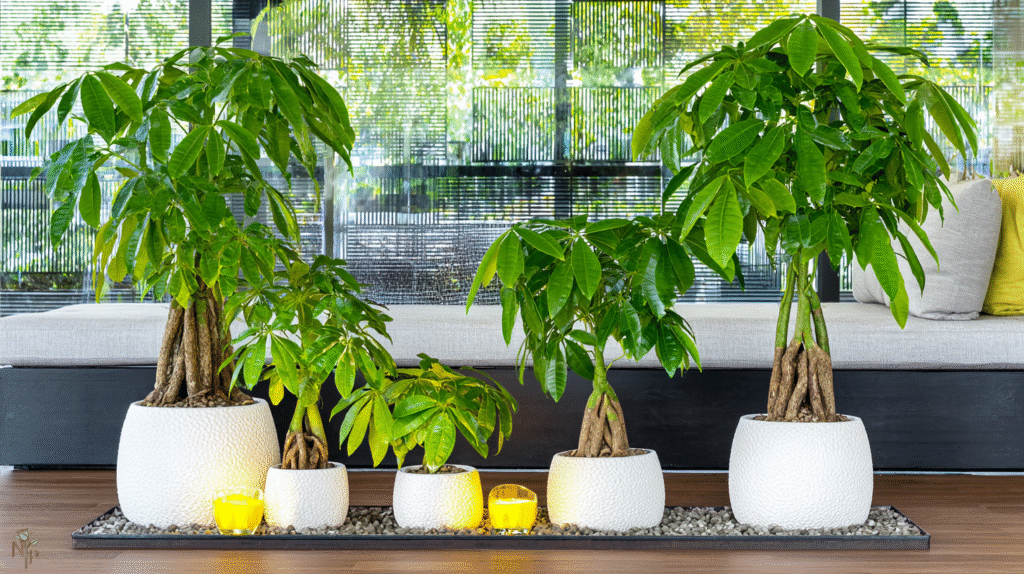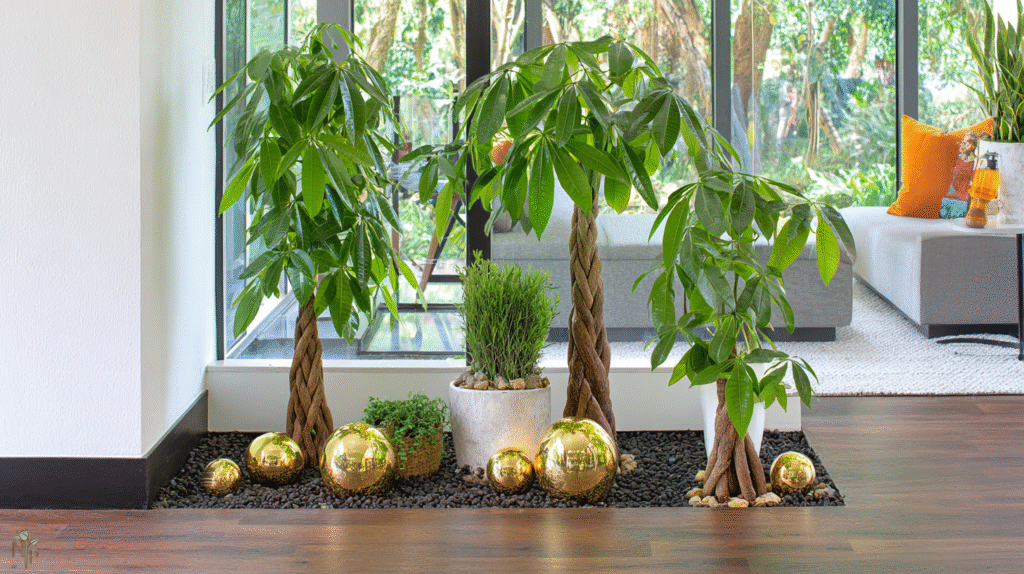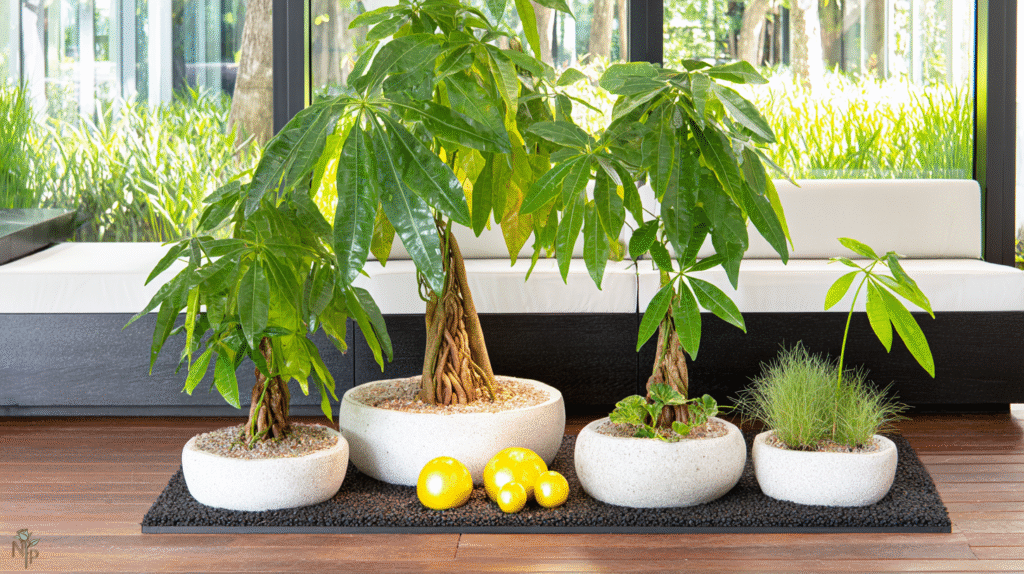My first “money tree” cost me $89 at a boutique plant shop. The braided trunk was perfect, the leaves glossy, and the ceramic pot was gorgeous. The shop owner assured me it was a “premium specimen” that would bring prosperity to my home.
It was dead in six weeks. Turns out, it wasn’t even a real money tree — it was a ficus benjamina with a braided trunk. I’d paid luxury prices for a $20 plant in a fancy pot.
That expensive lesson launched my money tree education. Three years and eight money trees later (yes, I have a problem), I know exactly where to find authentic Pachira aquatica plants without getting ripped off. Here’s everything I learned about buying real money trees and avoiding the scams that caught me.
What IS a Real Money Tree Anyway?
First things first — let’s identify what you’re actually looking for. Real money trees (Pachira aquatica) have:
- Five to seven leaflets per stem (like a hand)
- Naturally thick, often braided trunk
- Smooth, green bark when young
- Can develop a swollen base over time
- Native to Central and South American wetlands
Common imposters I’ve encountered:
- Ficus benjamina (braided) — what I bought
- Ficus elastica — completely different leaves
- Schefflera (umbrella tree) — similar leaves, wrong growth pattern
- Random braided plants labeled “money tree”
That boutique shop wasn’t technically lying — in some cultures, any braided plant can be called a money tree. But when most people want a money tree, they want Pachira aquatica.
The Surprising Best Places to Buy
After overpaying dramatically, I discovered the best money trees often come from the most unexpected places:
Grocery Stores (My #1 Pick) Trader Joe’s, Whole Foods, and even Kroger regularly stock real money trees.
- Price: $12-25
- Usually 6-10 inches tall
- Fresh shipments weekly
- High turnover = healthy plants
My healthiest money tree came from Trader Joe’s for $16. It’s now 5 feet tall.
Home Improvement Stores Home Depot and Lowe’s are goldmines if you know when to shop.
- Price: $15-40 depending on size
- Best selection in spring
- Check the tropical houseplant section
- Ask when shipments arrive
Costco (Seasonal Gem) When Costco has them, they’re amazing deals.
- Price: $20-30 for large plants
- Usually braided, 2-3 feet tall
- Limited availability
- Worth checking regularly
Asian Supermarkets Often overlooked but fantastic source.
- Price: $10-30
- Cultural significance = they stock real ones
- Usually excellent quality
- Lunar New Year = best selection

Where to Be Cautious
Instagram Plant Shops Pretty feeds don’t mean authentic plants. I’ve seen:
- Mislabeled plants constantly
- Inflated prices for small sizes
- “Rare” money trees that aren’t rare
- Shipping stress on tropical plants
Facebook Marketplace Hit or miss. Problems I’ve encountered:
- People selling any braided plant as money tree
- Root-bound, neglected plants
- “Just propagated!” (money trees are hard to propagate)
- No recourse if plant dies
Boutique Plant Shops Where I got scammed initially. Watch for:
- Massive markups for “curated” plants
- Fancy pots hiding root problems
- Vague answers about plant species
- “Energy-cleansed” premium pricing
Online Sources That Actually Work
After three shipping disasters, here are online sources I trust:
The Sill
- Pricier but reliable identification
- Good packaging
- 30-day guarantee
- Actually labels Pachira aquatica correctly
Bloomscape
- Larger specimens available
- Excellent shipping protection
- Real customer service
- Clear photos match what arrives
Etsy (Carefully)
- Check seller reviews religiously
- Message about species before buying
- Look for shops specializing in tropicals
- Avoid sellers with mixed plant types
Costa Farms (Through Retailers)
- Major supplier to stores
- Website shows where to buy locally
- Consistent quality
- Proper labeling
Red Flags to Avoid Getting Scammed
Pricing Red Flags:
- Under $10 for anything over 6 inches (probably not Pachira)
- Over $50 for standard braided tree under 2 feet
- “Rare variegated money tree” (doesn’t exist)
- Massive pot upgrade charges
Description Red Flags:
- Won’t specify Pachira aquatica
- “Money tree mix” or “prosperity plant”
- No clear photos of leaves
- Stock photos only
Seller Red Flags:
- Can’t answer basic care questions
- Defensive about species verification
- No return/guarantee policy
- Bad reviews mentioning wrong plants
How to Verify You’re Getting the Real Deal
Before buying, check:
- Leaf formation (5-7 leaflets)
- Trunk color and texture
- Overall growth pattern
- Ask directly: “Is this Pachira aquatica?”
The leaflet test: Count the leaflets. Real money trees have 5-7 per stem. If it has more or less, it’s not Pachira aquatica. This simple check would have saved me $89.
The trunk check: Young Pachira has green, smooth bark. Older ones develop greyish bark. If the braided trunk has rough, brown bark throughout, probably not a money tree.

Seasonal Shopping Strategy
Best times to buy:
- Late spring: New shipments, best selection
- Lunar New Year: Asian markets stock up
- September: End of growing season sales
- Post-holiday: Clearance on gift plants
Worst times:
- December: Inflated gift prices
- Mid-summer: Shipping stress, limited stock
- Valentine’s Day: Random plants labeled “money”
- Mother’s Day: Peak pricing
What to Look for in a Healthy Money Tree
Green flags:
- Firm, turgid leaves
- No yellow or brown spots
- Well-formed braid (if braided)
- No wobbly trunk
- New growth visible
- Appropriate pot size
Run away from:
- Yellowing leaves
- Soft spots on trunk
- Soil pulling away from pot edges
- No new growth
- Fungus gnats
- Clearance rack (unless you’re experienced)
My Current Money Tree Buying Strategy
- Check Trader Joe’s first — Best prices, frequent fresh stock
- Visit Home Depot/Lowe’s early spring — Bigger selection
- Asian markets during cultural holidays — Hidden gems
- Costco when available — Best size-to-price ratio
- Online only for specific sizes — When local fails
Price Reality Check
Here’s what you should actually pay:
4-6 inch pot: $10-20 8-10 inch pot: $20-40 12+ inch, braided: $40-80 3+ feet tall: $60-150
Anything way outside these ranges? Question it.
The Happy Ending to My Scam Story
That $89 fake money tree taught me an expensive lesson. But it also launched my obsession with finding real ones at fair prices. My current collection includes:
- Trader Joe’s find: $16 → now 5 feet tall
- Home Depot rescue: $25 → thriving 3-foot beauty
- Costco score: $30 → massive braided specimen
- Asian market gem: $15 → my fullest, happiest tree
Total spent on real money trees: Less than that one fake.

Your Money Tree Shopping Checklist
✓ Verify it’s Pachira aquatica
✓ Count leaflets (5-7)
✓ Check trunk condition
✓ Compare prices across sources
✓ Buy from high-turnover locations
✓ Avoid Instagram markup
✓ Trust grocery stores
✓ Question “rare” varieties
✓ Skip the fancy pot initially
The Bottom Line
Real money trees are everywhere once you know where to look and what to avoid. Skip the boutique plant shops with their “curated specimens” and head to Trader Joe’s. That $16 money tree will grow just as well — better, probably, since it hasn’t been sitting in a shop for weeks.
My expensive fake taught me that the best money trees often come from the humblest sources. Now I get a little thrill every time I see someone post their $80 boutique money tree on Instagram, knowing I have the same plant that cost me $16 at a grocery store.
Start at Trader Joe’s. Seriously. Thank me later. 💰🌳






